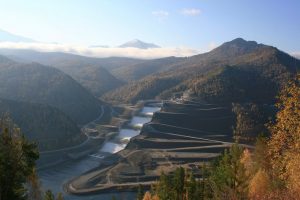
The Republic of Khakassia is a subject of the Russian Federation, a republic in its composition. Included in the Siberian Federal District, it is part of the East Siberian Economic Region. The capital is the city of Abakan. In the north and east it borders with the Krasnoyarsk Territory, in the south with the Republic of Tyva and the Republic of Altai, in the west with the Kemerovo Region of Russia. A unique thing about this place is that it is said to be the republic of miracles.
Khakassia is one of the few regions that have preserved their original culture, an amazing land where even today there is a place for mysticism. The area of Khakassia is slightly less than the area of the state of Latvia. In the Khakassky nature reserve, the traveler can see all the natural monuments of the republic: steppes stretching to the horizon, clear lakes and dense cedar forests. The mysterious Tuima technological failure, at the bottom of which there is a lake with turquoise water, the Siberian Stonehenge – the mountain range Chests, ancient menhirs and ethnic settlements – are the best places for lovers of riddles and adventurers.
Culture
Abakan is the cultural center of Khakassia. The Khakass National Museum of Local Lore named after L. R. Kyzlasova , National Library named after N. G. Domozhakov, Khakass Republican Philharmonic named after V. G. Chaptykov, Center for Culture and Folk Art named after S. P. Kadysheva, Abakan Art Gallery, Abakan Youth Palace, Pobeda City Culture Center, Railway Workers Culture House, and many more. Among the theaters operating in Abakan, there are two the most dramatic: the Russian Republican Drama Theater and the Khakass National Drama Theater. There are also the Khakass National Puppet Theater “Fairy Tale” and the Khakass State Small-Form Theater “Chitigen”.
The Climate and Territory
A variety of climatic and plant zones – from highlands with year-round glaciers and snow, tundra, forests and forest-steppes to steppes with ancient burial grounds – is typical for the republic. The climate in Khakassia is sharply continental, with dry, hot summers and cold, little snowy winters. The average air temperature in July is + 17.9 ° С, in January –18.9 ° С.
The prevailing terrain is steppes, mountains and taiga. The Sayan Mountains, whose height sometimes exceeds 2000 m, occupy two thirds of the territory of the republic. The largest rivers of Khakassia are the Yenisei, Abakan, Chulym and Tom. There are more than 500 lakes, rivers and small rivers in the republic. The total length of the rivers is 8 thousand km.
The area of the Republic of Khakassia is 61,900 km 2. This is 0.4% of the territory of the Russian Federation. The distance from the capital of the Republic of Khakassia – the city of Abakan to Moscow is 4218 km. The territory of Khakassia is divided into 8 districts. In total, there are 271 settlements in the republic.
The Natural Resources
Khakassia is one of the regions of the Russian Federation that are unique in terms of natural resources. Only in explored deposits are concentrated 25 percent of the all-Russian reserves of molybdenum, 27 percent of barite, 13 percent of facing stones, 6.5 percent of bentonite, 3 percent of coal. The mining of iron, gold, mineral and radon waters, barite, marble, granites also exist. Explored deposits of copper, phosphate rock, lead, zinc, asbestos, gypsum, jade, and jadeite are spread in the republic. There are proven reserves of oil and gas, too.
Gold mining played an important place in the development of the economy of the Khakassia-Minusinsk Territory, where the “gold rush” began in Siberia from the 30s-40s of the 19th century. By 1860, 127 mines operated in the Minusinsk and Achinsk districts. The main areas of gold mining were the mines of Saral, Bogomdarovanny (now the Kommunar mine) and Balakhchin. In 1852, 3,800 workers worked in the Minusinsk District on gold mines.
The Republic has significant resources of fresh groundwater and surface water. Almost all types of water bodies are available – mountain rivers, caravan lakes, foothill rivers, water bodies with a flat type of regime. The main waterway is the Yenisei River.
The total area of the forest fund is 65 percent of the entire territory of the republic. The total timber stock is 444.3 million m³, including coniferous species 363.9 million m³. Of particular value are cedar forests. Specially protected natural territories occupy 7.6 percent of the republic’s area.
The historical development of the peoples of Khakassia proceeded in relatively favorable climatic conditions, and in the course of this development, a unique cultural heritage was created, representing an invaluable resource for the development of the region. Therefore, the basis of the cultural heritage of Khakassia is made up of natural and archaeological landscapes composed of tens of thousands of archaeological sites.
Visiting Khakassia
Khakassia is a hospitable picturesque region where the steppes, rich in healing lakes, lie at the foot of beautiful mountains. Here, swift rivers and mysterious caves attract adventurers from all over the Earth.
The territory of Khakassia is rightfully considered one of the most saturated with monuments of archeology of the regions of Russia. This is a region with a rich history and ancient culture that has preserved more than 30 thousand archaeological sites – stone sculptures and barrows, rock paintings and ancient sanctuaries, the remains of settlements and magnificent mountain fortresses.
The mystery of Khakassia is the secret of the place where nature itself tried to prepare all the conditions for human life. The mild climate, landscapes, ancient monuments, untouched corners of nature, the combination of the gold of the steppes, the crimson mountains with the greenery of the taiga and the blue sky, even the whimsical horizon line – all this has an irresistible appeal to the guests of Khakassia. Khakassia is a place of miracle where you want to live.
